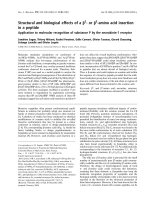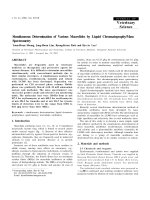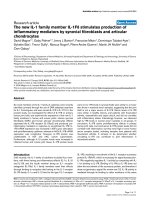Determination of vertical derivative of gravity anomalous by upward continuation and Taylor series transform methods: Application to the Southwest sub-basin of the East Vietnam
Bạn đang xem bản rút gọn của tài liệu. Xem và tải ngay bản đầy đủ của tài liệu tại đây (3.4 MB, 10 trang )
Vietnam Journal of Marine Science and Technology 2022, 22(2) 133–142
Vietnam Academy of Science and Technology
Vietnam Journal of Marine Science and Technology
journal homepage: vjs.ac.vn/index.php/jmst
Determination of vertical derivative of gravity anomalous by upward
continuation and Taylor series transform methods: application to the
Southwest sub-basin of the East Vietnam Sea
Nguyen Nhu Trung1,2,*, Tran Van Kha1, Bui Van Nam1,2
1
Institute of Marine Geology and Geophysics, VAST, Vietnam
Graduate University of Science and Technology, VAST, Vietnam
*
E-mail:
2
Received: 10 January 2022; Accepted: 28 April 2022
ABSTRACT
The vertical derivative of the gravity anomaly has a vital role in the methods of geological structure research
such as determining fault systems and the location of the field sources. In addition, the vertical derivative is
also used to calculate the downward continuation and further clarify the image of the seabed topography.
However, determining the vertical derivative according to the traditional Fast Fourier Transform (FFT)
method is often unstable and has low accuracy in high-order derivatives for high noise actual data. In this
article, we introduce a new calculation method to determine the vertical derivative of gravity anomaly giving
higher stable and accurate than traditional methods. The method is verified on synthetic model data and
actual data of the Southwest sub-basin of the East Vietnam Sea.
Keywords: Gravity anomaly, vertical derivative, Taylor series, fast Fourier transform.
Citation: Nguyen Nhu Trung, Tran Van Kha, and Bui Van Nam, 2022. Determination of vertical derivative of gravity
anomalous by upward continuation and Taylor series transform methods: application to the Southwest sub-basin of the
East Vietnam Sea. Vietnam Journal of Marine Science and Technology, 22(2), 133–142. />ISSN 1859-3097/© 2022 Vietnam Academy of Science and Technology (VAST)
133
Nguyen Nhu Trung et al./Vietnam Journal of Marine Science and Technology 2022, 22(2) 133–142
INTRODUCTION
Calculating the vertical derivative of
gravity anomaly is an essential method in
gravimetric data processing methods to
determine the boundary of geological structure
or fault system [1–5]. In addition, the vertical
derivative is also used in calculating the
downward continuation [6–12] to increase the
accuracy when determining the topography of
boundary surfaces such as sedimentary
foundations and seabed topography [13, 14]. It
is easy to see that the vertical derivative
dramatically affects the accuracy of the above
calculation methods. In previous studies, the
authors mainly used the vertical derivative
through the frequency domain, such as fast
Fourier transform (FFT), Hilbert transform
[15, 16], or the method of Laplace equation
[17]. However, Kha and Trung [12] published
a new technique using the the upward
continuation and Taylor series expansion
methods (UCT) to calculate the vertical
derivative, and showed that the calculation of
the vertical derivative through the frequency
domain is unstable when the data have noises,
especially in case of higher-order vertical
derivatives, which can affect the results of
determining the structural boundary as well as
the stability in the downward continuation
problem. This UCT method has increased the
accuracy and stability of the calculation of the
higher order vertical derivatives than previous
traditional methods such as FFT, Hilbert, or
Laplace methods. Recently, some authors have
also been used the UCT method in calculating
gravity tensors [18–20], the vertical derivative
in determining the structural boundaries of the
Witwatersrand basin, South Africa [3]. Trung
et al., (2020) [14] used the UCT method to
calculate the downward continuation of the
Bouguer anomaly data to the near seabed, then
reverted this downward continuation gravity
anomaly data to determine the sediment
basement. The obtained results have higher
resolution and reliability than the conventional
calculation method.
To see the important application meaning
of calculating the vertical derivative in the
analysis of gravity data, in this article, we
introduce the method of calculating the first
and second vertical derivatives of the gravity
anomaly according to the UCT method [12].
The results of applying the UCT method to
calculate the vertical derivative of gravity
anomalies have been verified on synthetic
model data and actual data in the Central Basin
of the East Vietnam Sea, giving results with
high accuracy and stability than previous
traditional methods, especially in the case of
high random noise data.
THEORETICAL
BASIS
OF
THE
METHOD
Assuming f(x, y, z) is a potential field
measured at an observation plane of height z, in
the Decartes coordinate system, the z-axis
positive direction is downward. The potential
field at height (z – ∆h) is f(x, y, z – ∆h) which
can be represented by Taylor series as follows
[7, 17]:
( −∆h ) f n x, y, z
∆h 2
f ( x, y , z =
− ∆h ) f ( x, z ) − ∆hf ′ ( x, y, z ) +
f ′′ + ... +
(
)
n!
2!
n
where: (fʹ(x, y, z), fʹʹ(x, y, z),…, fn(x, y, z)) are
the vertical derivatives in order of 1, 2,…, n. In
this study, we do not determine these vertical
derivative values according to the traditional
fast Fuorier transform (FFT) method, but
determine them through the gravity anomaly at
134
(1)
the different upward continuation level (f(x, y, z
– ∆h), f(x, y, z – 2∆h),…, f(x, y, z – n∆h).
We consider equation (1) with a Taylor
series expansion of n = 1, 2,…, N and ∆h is
positive and small enough, then we have the
following system of equations:
Nguyen Nhu Trung et al./Vietnam Journal of Marine Science and Technology 2022, 22(2) 133–142
n
2
( −∆h ) f ′′ x, y, z + ... + ( −∆h ) f n x, y, z
, z − ∆h ) f ( x, y, z ) − ∆hf ′ ( x, y, z ) +
f ( x , y=
)
(
)
(
n!
2!
n
2
−2∆h )
−2∆h ) n
(
(
f ′′ ( x, y, z ) + ... +
f ( x, y, z ) (2)
− 2∆h ) f ( x, y, z ) − 2∆hf ′ ( x, y, z ) +
f ( x, y , z =
n!
2!
n
2
( −n∆h ) f ′′ x, y, z + ... + ( −n∆h ) f n x, y, z
f ( x, y , z =
− n∆h ) f ( x, y, z ) − n∆hf ′ ( x, y, z ) +
(
)
)
(
n!
2!
The equations (2) can be written in the
−∆h
−2∆h
− n∆h
( −∆h )
2
2!
( −2∆h )
2
2!
( −n∆h )
( −∆h )
n
n!
( −2∆h )
n
n!
2
2!
( −n∆h )
n!
n
f ′ ( x, y, z ) f ( x, y, z − ∆h ) − f ( x, y, z )
f ′′ ( x, y, z ) f ( x, y, z − 2∆h ) − f ( x, y, z )
=
f n ( x, y, z ) f ( x, y, z − n∆h ) − f ( x, y, z )
+
(3)
For n = 8, solving equation (3) we get the
vertical derivatives from the 1st to 8th order.
Here is the definite formula for the vertical
derivatives of the 1st, 2nd and 3rd order:
Solve the linear matrix equation (3) with
the unknowns being the derivatives of order
n = 1, 2,…, N (fʹ(x, y, z), fʹʹ(x, y, z),…,
fn(x, y, z)).
f ′ ( x, y , z ) =
form of matrix equation (3) as follows:
2283 f ( x, y, z ) − 6720 f ( x, y, z − ∆h ) + 11760 f ( x, y, z − 2∆h ) − 15680 f ( x, y, z − 3∆h )
840∆h
14700 f ( x, y, z − 4∆h ) − 9408 f ( x, y, z − 5∆h ) + 3920 f ( x, y, z − 6∆h ) − 960 f ( x, y, z − 7 ∆h ) + 105 f ( x, y, z − 8∆h )
(4)
840∆h
f ′′ ( x, y, z ) =
29531 f ( x, y, z ) − 138528 f ( x, y, z − ∆h ) + 312984 f ( x, y, z − 2∆h ) − 448672 f ( x, y, z − 3∆h )
+
+
f ′′′ ( x, y, z ) =
+
+
5040∆h 2
435330 f ( x, y, z − 4∆h ) − 284256 f ( x, y, z − 5∆h ) + 120008 f ( x, y, z − 6∆h ) − 29664 f ( x, y, z − 7 ∆h )
5040∆h
3267 f ( x, y, z − 8∆h )
(5)
2
5040∆h 2
2403 f ( x, y, z ) − 13960 f ( x, y, z − ∆h ) + 36706 f ( x, y, z − 2∆h ) − 57384 f ( x, y, z − 3∆h )
240∆h3
58280 f ( x, y, z − 4∆h ) − 39128 f ( x, y, z − 5∆h ) + 16830 f ( x, y, z − 6∆h ) − 4216 f ( x, y, z − 7 ∆h )
469 f ( x, y, z − 8∆h )
(6)
240∆h3
240∆h3
The 1st, 2nd, and 3rd vertical derivative in the
fomulas (7), (8), and (9) are defined from the
gravity anomalies upward continued at the
elevation ∆h, 2∆h,…, 8∆h. Calculation results
using these formulas give us a more stable and
accurate vertical derivative value than other
135
Nguyen Nhu Trung et al./Vietnam Journal of Marine Science and Technology 2022, 22(2) 133–142
conventional calculation methods, especially in
the case of noisy data [12].
APPLY ON SYNTHETIC MODEL
The theoretical model investigated in this
study is a rectangular prism with physical
parameters, as shown in Table 1. Gravity
anomalies on the obseved surface of the
rectangular prism are shown in Figure 1a. The
first, second, and third order vertical derivatives
of the gravity anomaly of the rectangular prism
are calculated by equations (4), (5), and (6) for
both correct gravity anomaly data (without
random noise) and plus 5% random noise. The
results of calculating the vertical derivative by
formulas (4), (5) and (6) are compared with the
result of calculating the vertical derivative by
the traditional FFT method.
Table 1. Physical parameters of the prism model
X1 (km)
60
X2 (km)
65
Dx (km)
0.5
Z1 (km)
3
Z2 (km)
6
Mật độ dư (g/cm3)
0.2
Figure 1. a) Gravity anomaly of rectangular prisms; b) Rectangular prism model
with physical parameters in Table 1
The calculation results of the first,
second, and third order vertical derivatives in
Figure 2 show that in the case of data without
noise (exact data), the difference between the
vertical derivative is calculated by the FFT
method and the UCT method is a minimal
error and almost the same (Table 2 and
Figure 2). The vertical derivative values have
minor errors compared with the theoretical
values in all three cases of first, second, and
third derivatives (Table 2). Thus, with correct
data, the vertical derivatives are calculated by
the FFT method, and the UCT method does
not see the difference.
Table 2. Root mean square error (RMSE) of the first, second and third order vertical derivatives
are caluclated by FFT and UCT methods in the case of the correct gravity anomaly
Root mean square
error
FFT method
UCT method
The 1st vertical derivative
(mGal)
0.00267
0.00267
The 2nd vertical derivative
(mGal)
0.00086
0.00086
When the gravity anomaly is added 5%
random noise, the vertical derivative
calculated by the UCT and the FFT methods
are very different (Figure 3). The vertical
derivative calculated by the FFT method
gives very poor results. The vertical
136
The 3rd vertical derivative
(mGal)
0.00154
0.00144
derivative value is noisy and unstable: The
first order vertical derivative (red line in
Figure 3a) appears relatively large sawtooth
pulses at the high anomalous amplitude
region. The 2nd and 3rd order derivatives (red
lines in Figures 3b and 3c) are instability, the
Nguyen Nhu Trung et al./Vietnam Journal of Marine Science and Technology 2022, 22(2) 133–142
vertical derivative value is strongly
perturbed, and the amplitude is completely
different from its true value (amplitude is
larger 10 times for the second-order
derivative and 100 times for the third-order
derivative). The vertical derivative calculated
by the UCT method gives very good results
in the first-order vertical derivative
(Figure 3a), and even with the second-order
vertical derivative, the value is consistent
with the theoretical value (3b). For the third
order vertical derivative (Figure 3c), although
there is a discrepancy between the theoretical
and calculated results, the shape of the
vertical derivative graph is quite consistent
with the theoretical derivative.
Figure 2. The vertical derivative of gravity anomaly of the rectangular prism calculated by the
FFT method and the UCT method almost coincides with the theoretical value; a) the first order
vertical derivative; b) the 2nd order vertical derivative; c) the 3rd order vertical derivative
Figure 3. Vertical derivative of gravity anomaly of a prism (Figure 1) when the gravity anomaly is
added 5% random noise; a) the 1st order vertical derivative; b) the 2nd order vertical derivative;
c) the 3rd order vertical derivative
137
Nguyen Nhu Trung et al./Vietnam Journal of Marine Science and Technology 2022, 22(2) 133–142
Thus, it can be seen that, in the case of
measured data with random noise, the
calculation of the vertical derivative by the
method proposed by Kha and Trung (2020)
[12] gives very high accurate and stable results
while the results calculated by the FFT method
have low accuracy and unstable results,
especially in the case of second and third order
derivatives.
VERTICAL DERIVATIVE OF GRAVITY
ANOMALY IN THE SOUTHWEST OF THE
CENTRAL BASIN, EAST VIETNAM SEA
The study area is located in the southwest
of the Central Basin of the East Vietnam Sea
(Figure 4), including the area of the Southwest
sub-basin in the center, a part of the Hoang Sa
islands in the North and a part of the Truong Sa
islands in the South (Figure 4a). Figure 4b is
the Bouguer gravity anomaly calculated from
the free-air satellite gravity anomaly data with
1’ × 1’ resolution ( V29.1 [22] and bathymetry
data from GEBCO source with 15” × 15”
resolution. ( />products/gridded_bathymetry_data/).
The
results of calculating the first-order vertical
derivative by the UTC method (Figure 5a) have
stable values, except for some areas Northeast
of the Southwest sub-basin. The first order
vertical derivative map has sharp positive and
negative anomalies, clearly reflecting the
geological structure system in the study area,
such as spreading ridge axis, continental oceanic crust boundary, NE-SW fault system,
and sub-meridian, sub-latitude faults (Figure 4a
and Figure 5a). The first order vertical
derivative map calculated by the FFT method
gives much worse results: in the Southwest
sub-basin and the boundary of the oceaniccontinental crust. The first order vertical
derivative appears in many speckled spots
showing unstable perturbation of the
calculation results (Figure 5c). The calculations
of the second vertical derivative show that for
the UTC method, the derivative value also
appears a little unstable in some sub-regions of
the southwest basin, such as along the
spreading ridge axis in the northeast (Fig. 5b).
However, this map has reflected quite well the
structural elements in the study area, such as
the spreading ridge axis, NE-SW, and submeridian fault systems. On the contrary,
looking at the results of calculating the second
derivative by the FFT method (Figure 5d), we
see that the obtained results are fuzzy. The
second derivative values fluctuate very
strongly, forming unstable value regions, and
the gravity field image does not reflect the
structural elements in the study area.
Figure 4. (a) Diagram of fault system [21] and location of the study area;
(b) Bouguer gravity anomaly map of the study area
138
Nguyen Nhu Trung et al./Vietnam Journal of Marine Science and Technology 2022, 22(2) 133–142
(a)
(b)
(c)
(d)
Figure 5. Vertical derivative maps of the Bouguer anomaly in the study area: the first (a) and
second (b) order vertical derivatives are calculated by the UCT method, and the first (c) and
second (d) derivatives are calculated by the FFT method
Some methods for determining the
horizontal boundary of the field sources using
vertical derivatives [1–4, 22–24] calculated by
the FFT method will inevitably lead to
instability in the calculation results. For
example, below is the result of calculating the
logistic function of the total horizontal gradient
(LTHG) [3] using the vertical derivative of the
entire horizontal gradient:
139
Nguyen Nhu Trung et al./Vietnam Journal of Marine Science and Technology 2022, 22(2) 133–142
∂THG
∂z
LTHG =
1 + exp −
2
2
∂THG ∂THG
+
∂x ∂y
We see the LTHG formula that if we use
the FFT method to calculate the vertical
derivative, the result will be far different from
the UTC method. Figure 6a is a map of LTHG
calculated by the UTC method with very stable
results, the sequence of peak points is obvious.
(a)
−α
Meanwhile, the LTHG map calculated by the
FFT method (Figure 6b) gives bad results in the
Southwest sub-basin. It is clear that the
accuracy of the vertical derivative has a
significant influence on the quality of the
LTHG map.
(b)
Figure 6. Comparison of results of calculating LTHG by UTC method (a) and by FFT method (b)
CONCLUTION
Equations (4), (5), and (6) allow for the
calculation of the first, second, and third
derivatives of potential field anomalies with
higher stability and accuracy than the
conventional methods, especially in case of the
noisy data. Calculating the first and second
order vertical derivatives of the gravity
anomaly by the UTC method achieves high
accuracy, making an important contribution to
the processing and interpretation of gravity data
using vertical derivative: the obtained results
have high accuracy and stability easier to
140
determine the horizontal geological structure
boundaries. The UTC method can be used to
calculate the downward continuation over some
deep water areas to increase the detail of local,
shallow
geological
structures,
thereby
contributing to clarifying the image of
geological structure in the study area.
Acknowledgements: This research is funded
by Vietnam National Foundation for Science
and Technology Development (NAFOSTED)
under grant number 105.99-2017.318 and
Vietnam
Academy
of
Science
and
Nguyen Nhu Trung et al./Vietnam Journal of Marine Science and Technology 2022, 22(2) 133–142
Technology
under
VAST06.01/21–22.
grand
number
REFERENCES
[1] Miller, H. G., and Singh, V., 1994.
Potential field tilt—a new concept for
location of potential field sources.
Journal of applied Geophysics, 32(2-3),
213–217. />[2] Pham, L. T., Oksum, E., Do, T. D., and
Huy, M. L., 2018. New method for edges
detection of magnetic sources using
logistic function. Geofizicheskiy Zhurnal,
40(6), 127–135. />gzh.0203-3100.v40i6.2018.151033
[3] Pham, L. T., Van Vu, T., Le Thi, S., and
Trinh, P. T., 2020. Enhancement of
potential field source boundaries using an
improved logistic filter. Pure and Applied
Geophysics,
177(11),
5237–5249.
/>[4] Cooper, G. R. J., and Cowan, D. R., 2006.
Enhancing potential field data using
filters based on the local phase.
Computers & Geosciences, 32(10), 1585–
1591.
/>2006.02.016
[5] Nasuti, Y., Nasuti, A., and Moghadas, D.,
2019. STDR: A novel approach for
enhancing and edge detection of potential
field data. Pure and Applied Geophysics,
176(2), 827–841. />s00024-018-2016-5
[6] Evjen, H. M., 1936. The place of the
vertical
gradient
in
gravitational
interpretations. Geophysics, 1(1), 127–
136. />[7] Peters, L. J., 1949. The direct approach to
magnetic interpretation and its practical
application. Geophysics, 14(3), 290–320.
/>[8] Trejo, C. A., 1954. A note on downward
continuation of gravity. Geophysics,
19(1), 71–75. doi: 10.1190/1.1437972
[9] Ackerman,
J.,
1971.
Downward
continuation using the measured vertical
gradient. Geophysics, 36(3), 609–612.
/>
[10] Zhang, H., Ravat, D., and Hu, X., 2013.
An improved and stable downward
continuation of potential field data: The
truncated
Taylor
series
iterative
downward continuation methodImproved
and stable downward continuation.
Geophysics,
78(5),
J75–J86.
/>[11] Abedi, M., Gholami, A., and Norouzi, G.
H.,
2013.
A
stable
downward
continuation of airborne magnetic data: A
case study for mineral prospectivity
mapping in Central Iran. Computers &
Geosciences, 52, 269–280. />10.1016/j.cageo.2012.11.006
[12] Tran, K. V., & Nguyen, T. N., 2020. A
novel method for computing the vertical
gradients of the potential field:
application to downward continuation.
Geophysical
Journal
International,
220(2),
1316–1329.
/>10.1093/gji/ggz524
[13] Hu, M., Li, L., Jin, T., Jiang, W., Wen,
H., and Li, J., 2021. A new 1′× 1′ global
seafloor topography model predicted from
satellite altimetric vertical gravity
gradient anomaly and ship soundings
BAT_VGG2021. Remote Sensing, 13(17),
3515. />[14] Nguyen, T. N., Van Kha, T., Van Nam,
B., and Nguyen, H. T. T., 2020.
Sedimentary basement structure of the
Southwest Sub-basin of the East Vietnam
Sea by 3D direct gravity inversion.
Marine Geophysical Research, 41(1), 1–
12. doi: 10.1007/s11001-020-09406-w
[15] Hinojosa, J. H., and Mickus, K. L., 2002.
Hilbert transform of gravity gradient
profiles: Special cases of the general
gravity-gradient tensor in the Fourier
transform domain. Geophysics, 67(3),
766–769. doi: 10.1190/1.1484519
[16] Ramadass, G., Arunkumar, I., Rao, S. M.,
Mohan, N. L., and Sundararajan, N.,
1987. Auxiliary functions of the Hilbert
transform in the study of gravity
anomalies. Proceedings of the Indian
Academy of Sciences-Earth and Planetary
Sciences, 96(3), 211–219. />10.1007/BF02841613
141
Nguyen Nhu Trung et al./Vietnam Journal of Marine Science and Technology 2022, 22(2) 133–142
[17] Fedi, M., and Florio, G., 2002. A stable
downward continuation by using the
ISVD method. Geophysical Journal
International, 151(1), 146–156. doi:
10.1046/j.1365-246X.2002.01767.x
[18] Chen, T., and Yang, D., 2022. Gravity
gradient tensors derived from radial
component of gravity vector using Taylor
series expansion. Geophysical Journal
International,
228(1),
412–431.
/>[19] Liu, J., Liang, X., Ye, Z., Liu, Z., Lang,
J., Wang, G., and Liu, L., 2020.
Combining multi-source data to construct
full tensor of regional airborne gravity
gradient disturbance. Chinese Journal of
Geophysics, 63(8), 3131–3143. doi:
10.6038/cjg2020O0044
[20] Liu, J., 2022. Using gravity gradient
component and their combination to
interpret the geological structures in the
eastern Tianshan Mountains. Geophysical
Journal International, 228(2), 982–998.
/>
142
[21] Nguyen, N. T., & Nguyen, T. T. H., 2013.
Topography of the Moho and earth crust
structure beneath the East Vietnam Sea
from 3D inversion of gravity field data.
Acta Geophysica, 61(2), 357–384. doi:
10.2478/s11600-012-0078-9
[22] Cooper, G. R., 2014. Reducing the
dependence of the analytic signal
amplitude of aeromagnetic data on the
source vector direction. Geophysics,
79(4), J55–J60. />geo2013-0319.1
[23] Ferreira, F. J., de Souza, J., de B. e S.
Bongiolo, A., and de Castro, L. G., 2013.
Enhancement of the total horizontal
gradient of magnetic anomalies using the
tilt angle. Geophysics, 78(3), J33–J41.
/>[24] Sumintadireja, P., Dahrin, D., and Grandis,
H., 2018. A Note on the Use of the Second
Vertical Derivative (SVD) of Gravity Data
with Reference to Indonesian Cases.
Journal of Engineering & Technological
Sciences, 50(1), 127–139.



![pastoral practices in high asia [electronic resource] agency of 'development' effected by modernisation, resettlement and transformation](https://media.store123doc.com/images/document/14/y/qp/medium_qpp1401382157.jpg)





